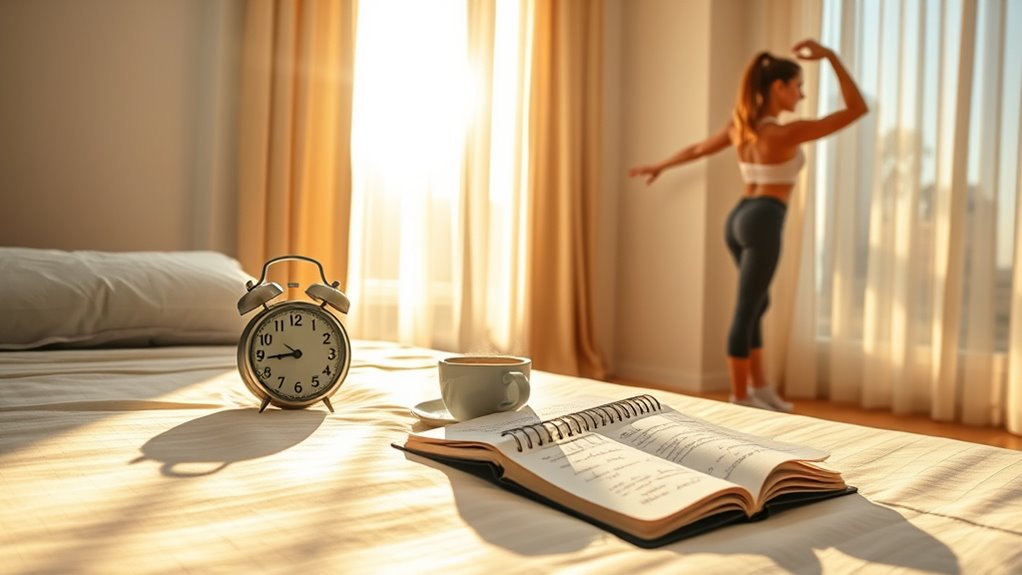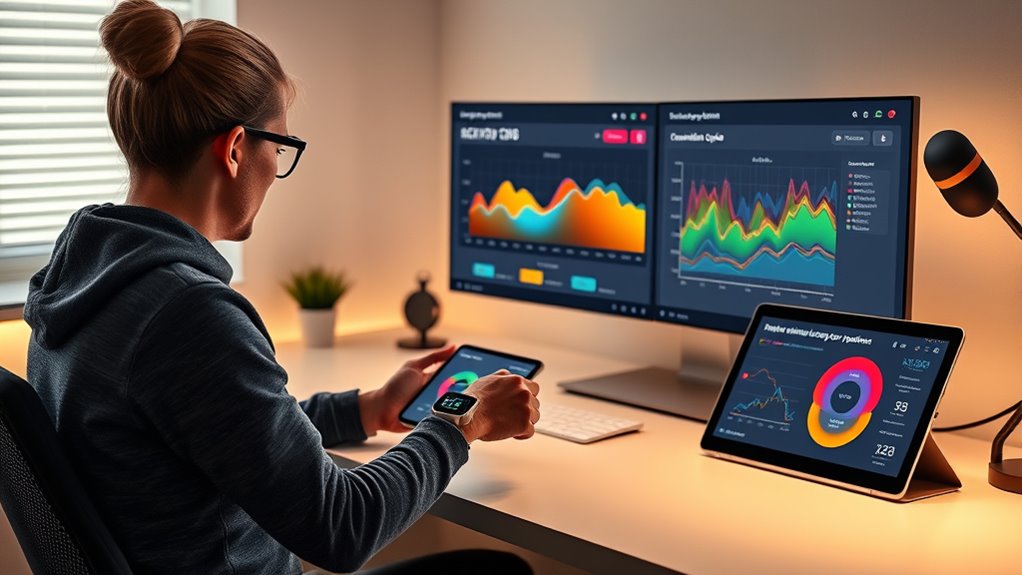To manage your energy effectively, identify your natural chronotype—whether you’re a morning lark or a night owl—by tracking your alertness and sleep patterns. Align demanding tasks with your peak times, like mornings for early risers or evenings for night owls, to boost productivity and well-being. Using tools such as sleep trackers and adjusting light exposure enhances your rhythm. Keep exploring to discover tailored strategies that help you optimize daily performance based on your internal clock.
Key Takeaways
- Identifying your chronotype helps schedule demanding tasks during natural energy peaks for optimal performance.
- Aligning sleep and activity routines with internal circadian rhythms enhances alertness and reduces fatigue.
- Morning types perform best with high-focus tasks in the early day, while night types excel later in the evening.
- Using light exposure and environmental controls can reinforce biological clocks and improve energy management.
- Tracking alertness and sleep patterns informs personalized routines that maximize productivity and well-being.
Understanding the Science Behind Chronotypes

Understanding the science behind chronotypes can help you better manage your energy levels throughout the day. Your body follows a natural circadian rhythm, a 24-hour internal clock that influences sleep, alertness, and physical performance. This rhythm controls the release of hormones like melatonin and cortisol, which regulate wakefulness and rest. Everyone’s circadian rhythm is slightly different, which means your ideal activity times may not match the traditional 9-to-5 schedule. By understanding how your body responds to these hormonal shifts, you can optimize your daily routines. For example, you might find you’re most alert in the late morning or early evening, while energy dips occur in the early afternoon or late at night. Recognizing these patterns helps you plan tasks around your body’s natural highs and lows. Additionally, being aware of internal biological clocks can assist in choosing tools or products that support your energy management. Tailoring your activities to your biological rhythms can significantly enhance productivity and overall well-being.
Identifying Your Personal Chronotype

Discovering your personal chronotype involves paying close attention to your natural energy patterns and daily habits. Start by tracking when you feel most alert and focused, as well as when you tend to feel sleepy or sluggish. Notice your peak energy times—are you most energized in the morning, afternoon, or evening? Keep a journal for a week, noting your sleep and wake times, mood, and productivity levels. Pay attention to how you feel after meals, during different parts of the day, and on weekends versus weekdays. Recognizing these patterns helps you identify whether you’re a morning, evening, or intermediate type. This awareness is the first step toward aligning your schedule with your body’s natural rhythms for better energy and performance. Incorporating vetted sleep routines can also enhance your understanding of your chronotype and optimize your daily energy levels.
The Benefits of Aligning Activities With Your Internal Clock

Aligning your daily activities with your internal clock can markedly boost your energy, productivity, and overall well-being. When you work in sync with your natural rhythms, you experience heightened focus during peak times and conserve energy during lows. This alignment reduces fatigue, prevents burnout, and enhances your mood. You’ll find it easier to complete tasks efficiently and feel more motivated throughout the day. Additionally, syncing activities with your internal clock can improve sleep quality and help regulate your circadian rhythm. To maximize these benefits, consider scheduling mentally demanding tasks during your most alert periods and lighter activities when your energy dips. Incorporating mindfulness techniques can further support your awareness of your body’s natural signals and optimize your daily schedule. As research in AI discoveries advances, personalized routines based on biological insights could soon become more accessible and effective. Recognizing the importance of sleep in maintaining optimal health can further enhance your energy management strategies, leading to better overall well-being. For example, understanding your chronotype can help tailor your daily routine to match your specific biological predispositions.
Strategies for Morning Larks to Maximize Morning Productivity

If you’re a morning lark, you can harness your natural tendency to be most alert early in the day by scheduling your most demanding tasks during these peak hours. Prioritize high-concentration activities like strategic planning, problem-solving, or creative work in the morning when your energy and focus are at their best. Keep less intensive chores, emails, or routine tasks for later in the day. Establish a consistent morning routine to reinforce your alertness, such as a healthy breakfast, light exercise, or meditation. Eliminate distractions during your peak hours by turning off notifications or finding a quiet workspace. Practicing seasonal variations can help you adapt your schedule to changing daylight and temperature, further enhancing your productivity. Incorporating sleep hygiene practices can also support your alertness and performance throughout the day. Additionally, staying well-hydrated with vegetable juices or other healthy beverages can boost your energy levels naturally. Including nutrient-rich beverages like smoothies or infused waters can further optimize your hydration and vitality. By aligning your schedule with your chronotype, you maximize productivity and set a positive tone for the rest of the day.
Tips for Night Owls to Enhance Evening Performance

To boost your evening productivity, start by optimizing your routines to suit your natural energy peaks. Make sure to prioritize rest and recovery so you stay alert and focused during your late hours. Small adjustments can make a big difference in how effectively you perform at night. Being aware of narcissistic traits can also help you set healthier boundaries and protect your energy during interactions. Participating in remote hackathons can provide stimulating mental exercises that align with your peak hours to maintain engagement and motivation. Incorporating aesthetic home decor elements that inspire you can also enhance your environment and support your evening focus. Additionally, checking the retail hours of nearby stores can ensure you have access to all necessary supplies during your productive hours.
Optimize Evening Routines
Evening routines play a vital role in boosting your performance and well-being as a night owl. Structuring your evening can help you wind down effectively, maintain energy levels, and prepare for optimal late-night productivity. To enhance your evening, consider establishing calming activities that signal your body it’s time to transition to rest. Limit exposure to blue light from screens, which can interfere with melatonin production. Incorporate light, nutritious snacks to sustain your energy without feeling sluggish. Creating a consistent routine helps condition your body to stay alert when needed and relax when it’s time to wind down. Being mindful of your home cinema setup, including screen placement and lighting, can also reduce eye strain and improve your overall viewing experience. Practice mindfulness or gentle stretching to reduce stress. Keep a dedicated workspace separate from relaxation areas. Limit caffeine intake after a certain hour to avoid disrupting your evening energy levels. Additionally, understanding cybersecurity vulnerabilities can help you protect your digital environment during late-night activities. Recognizing your chronotype can further optimize your evening routines by aligning activities with your natural alertness patterns. Incorporating sleep hygiene practices can also significantly improve your ability to wind down and fall asleep more easily.
Prioritize Rest and Recovery
Building on your efforts to create a calming evening routine, prioritizing rest and recovery guarantees you wake feeling refreshed and ready for the next day. To optimize your sleep, establish a consistent bedtime, even on weekends. Avoid screens at least an hour before sleep, as blue light disrupts melatonin production. Incorporate relaxing activities like reading or gentle stretches to wind down. Ensure your sleep environment is cool, dark, and quiet to promote deep rest. Don’t underestimate the power of a short nap earlier in the day if you’re feeling fatigued, but keep it brief—around 20 minutes—to avoid interfering with nighttime sleep. Regularly maintaining your sleep environment by checking for safe and effective sleep conditions can further enhance your rest. Creating a focused and distraction-free space can improve your sleep quality and overall recovery. Additionally, paying attention to Bedroom elements such as lighting, temperature, and decor can significantly contribute to a more restful sleep environment. Maintaining awareness of sleep hygiene practices is essential for ensuring optimal recovery and energy levels. Prioritizing recovery isn’t just about sleep; it’s about giving your body time to repair, recharge, and prepare for tomorrow’s evening productivity.
Adjusting Your Routine for Shift Workers and Irregular Schedules

Adjusting your routine for shift work and irregular schedules is key to maintaining energy. You can do this by tailoring your sleep times and managing light exposure to better match your work hours. These strategies help you stay alert and recover more effectively, no matter your schedule. Incorporating personalized sleep strategies based on your chronotype can further optimize your energy levels throughout your shifts. Additionally, selecting appropriate planters that suit your environment can create a more conducive space for rest and recovery during your off hours. Understanding your family background can also provide insights into your natural rhythms and preferences, helping you tailor your routine more effectively. Exploring natural remedies like herbal teas or juices may also support your energy management efforts during irregular hours.
Tailoring Sleep Schedules
To optimize your sleep when working irregular hours or rotating shifts, you need to tailor your routine to match your unique schedule. This means adjusting your sleep times to align as closely as possible with your natural rhythms, even if your shifts vary. Consistency is key—try to go to bed and wake up at similar times, regardless of shift changes. Use strategic naps to bridge gaps in rest, and create a restful environment that minimizes disruptions. Incorporating Sleep Environment Optimization techniques can further enhance your rest quality. Additionally, understanding and respecting your cultural sleep preferences can help you establish a more sustainable routine that aligns with your background and personal habits.
- Prioritize sleep during your main rest period, even if it’s unconventional
- Use blackout curtains or sleep masks to simulate night conditions
- Limit caffeine and screen exposure before sleep to improve quality
Optimizing Light Exposure
Light exposure plays a crucial role in regulating your internal clock, especially when working irregular hours or rotating shifts. To stay alert during night shifts, seek bright light exposure, like using a light therapy box, at the start of your shift. This signals your body that it’s daytime, helping you remain awake and alert. Conversely, after your shift, block out bright light with sunglasses or blackout curtains to prepare your body for sleep. During daytime sleep, minimize light exposure by wearing an eye mask or using blackout curtains. Consistent light routines help reinforce your circadian rhythm, improving sleep quality and daytime alertness. Adjusting your light exposure strategically allows you to better manage your energy levels, even with a challenging schedule. Incorporating smart controls to regulate light exposure can further optimize your circadian alignment and enhance overall well-being.
Tools and Technologies to Track Your Energy Cycles

Have you ever wondered how to accurately monitor your energy patterns throughout the day? Modern tools and technologies make tracking your energy cycles easier than ever. Wearable devices, like fitness trackers and smartwatches, provide real-time data on your activity, heart rate, and sleep quality. Mobile apps can analyze your sleep patterns and daily activity to identify your natural energy peaks. Additionally, biofeedback devices help measure physiological signals such as skin temperature and galvanic skin response, giving insight into your stress and alertness levels.
- Wearable devices for activity, sleep, and heart rate monitoring
- Mobile apps for sleep analysis and energy pattern tracking
- Biofeedback tools for physiological and stress response data
Practical Steps to Optimize Your Daily Schedule Based on Your Chronotype

Understanding your chronotype—the natural timing of your peak alertness and energy—empowers you to structure your day for maximum productivity and well-being. To optimize your schedule, identify your most alert periods and align key tasks accordingly. For morning types, tackle demanding work early; for evening types, shift challenging tasks later. Incorporate regular breaks to sustain energy and avoid burnout. Use this simple table to plan:
| Chronotype | Best Time for Focus | Ideal Break Time | Sleep Recommendations |
|---|---|---|---|
| Morning Lark | Early morning | Mid-morning | Sleep early, wake early |
| Night Owl | Evening | Late evening | Sleep late, wake late |
| Intermediate | Flexible | Midday | Consistent sleep schedule |
Adjust your daily rhythm based on your chronotype for peak performance.
Frequently Asked Questions
How Do Chronotypes Influence Long-Term Health Outcomes?
Your chronotype affects your long-term health by shaping your sleep patterns, activity levels, and hormone production. If your schedule aligns with your natural rhythm, you’ll likely experience better sleep, reduced stress, and a stronger immune system. Conversely, mismatched routines can lead to chronic issues like fatigue, metabolic problems, or cardiovascular risks. Prioritizing activities that match your chronotype helps promote overall well-being and healthier aging over time.
Can Chronotype Shift With Aging or Lifestyle Changes?
You might think your chronotype stays fixed, but it can shift with age or lifestyle changes. As you get older, your sleep-wake patterns often shift, making you more of a morning or evening person. Lifestyle factors like work schedules, stress, or sleep habits also influence your internal clock. While some traits are ingrained, many aspects of your chronotype are adaptable, allowing you to optimize your routines over time.
What Are the Common Signs of Misaligned Energy Patterns?
When your energy patterns are misaligned, you might notice you’re often tired during the day but struggle to sleep at night. You could feel sluggish or unfocused at times, especially during your usual peak hours. You might also experience mood swings or irritability and find it hard to stick to a routine. Recognizing these signs helps you adjust your schedule or habits to restore better energy balance.
How Do Chronotypes Affect Mental Health and Mood?
Imagine your body’s internal clock as a gentle rhythm guiding your mood and mental well-being. If your chronotype aligns well, you’ll likely feel more energized, focused, and balanced throughout the day. When it’s out of sync, you might experience mood swings, fatigue, or difficulty concentrating. Embracing your natural rhythm helps boost mental health, so honoring your chronotype allows you to feel more centered, happier, and resilient in daily life.
Are There Specific Diets Recommended for Different Chronotypes?
You might wonder if diets vary for different chronotypes. While specific diets aren’t universally prescribed, aligning your eating habits with your natural rhythms can boost overall health. For example, morning types may benefit from larger breakfasts, while evening types might prefer later, smaller meals. Prioritizing nutrient-dense foods at your peak alertness times can improve mood and energy. Listening to your body’s cues helps optimize your diet for your unique biological clock.
Conclusion
By understanding your chronotype, you can truly optimize your energy and productivity. While some believe aligning activities with your internal clock boosts performance, recent studies suggest it also enhances overall well-being. So, experiment with your schedule—trust your body’s natural rhythms and see how much more you can accomplish. Remember, shifting routines to match your chronotype isn’t just a myth; it’s backed by science and can transform your daily efficiency.










